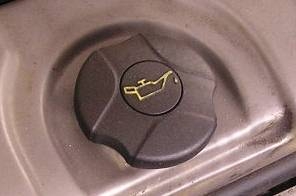
Selecting the right motor oil is a difficult and confusing process. With all of the strange motor oils competing and their confusing labels, you need to know how to quickly get the right motor oil without having to read through the entire label for details that are hidden in abbreviations and codes.
Check your car's manual for original equipment manufacturer recommendations and requirements specific to your car.
Look at the seal on the oil container that looks like two circles. Make sure that the circle has "API" on it which stands for "American Petroleum Institute." This means that the oil has been standardized to the API certification standards, which is true for most brands.
Right after the "API" on the label is a two letter code that starts with either a C or an S. The C is for oil made for diesel engines and the S means that the engine is made for gasoline engines. The second letter is a letter of the alphabet. If the letter is later in the alphabet, the grade is higher and will work in any engine indicated for that grade or lower (see the manual).
Select oil with the proper viscosity depending on the temperatures that your motor will need to withstand during operation. Look for this number in the middle of the inner circle below the API and two alphabet letter code. The first number, accompanied by a "W" is the measurement of the viscosity (thickness or oil weight) for the oil at start up/cold temperatures. The second number is the viscosity at the warmer temperature when the engine is running (the standard hot temperature). To find the operating range of temperatures, it will depend on how your motor (with its specific inside lubrication needs) interacts with motor oil with those properties.
Compare the oil's rating found in the center of the seal on the bottle to find the known operating ranges that you desire. According to the chart on the website CarBibles.com, the follow numbers are only a rough guide. Use 5W-20 or 5W-30 (colder climates) in temperatures below negative 30-degrees Celsius (weather temperature) to negative 10 degrees. Use 10W-40 and 10W-30 in temperatures -20 to 25 degrees above zero. Use 15W-40 and 15W-50 in ranges from -15 degrees to 30 degrees above zero. Use 20W-40 (temperate climates) and 20W-50 (hotter climates) in ranges from -10 degrees to 30 degrees above zero (a smaller range).
Use a high mileage oil to help expand and seal leaks if you notice that it may be an issue in older cars or cars with 75,000-miles or more. If you do not have any leaks from seals or do not notice any problems in your car, some experts recommend avoiding this additive, but the newer engine oils may cause your engine not to last as long since they are too refined and may be missing components that your engine was designed to have.
Synthetics and natural oils are a choice between highly modified/refined oils and less modified/refined oils. The natural oils are better for older cars that are high mileage in some situations but the synthetic oils do fewer things, but do them better. Usually, the synthetics will decrease the amount of sludge and should be used in newer cars.
Other additives should generally be avoided since they generally change the properties of the oil. For more details, see the Resources section.